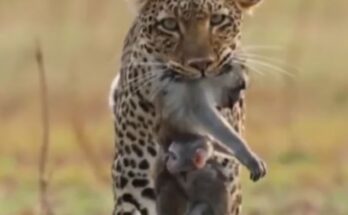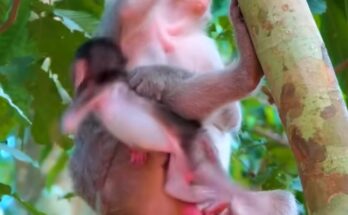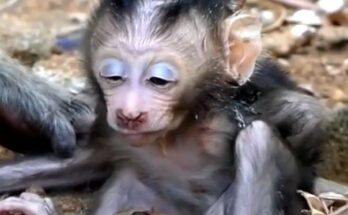The moment a newborn monkey enters the world, it is thrust into a realm of unpredictability, competition, and survival. Unlike many animals that can quickly get on their feet and move independently, primate infants—especially those of species like macaques, baboons, or howler monkeys—are born weak, small, and wholly dependent on their mothers. The phrase “Weak and Helpless Newborn Monkey Faces Life’s First Challenge Right After Its Birth” captures the raw vulnerability of this crucial moment in nature. It is a reminder of how even the smallest creatures begin life with immediate struggles, where the fight for survival begins not days or weeks later, but within minutes of birth.
Monkeys, being social animals, often live in complex troop structures. These groups offer protection and learning opportunities for the young, but they can also be harsh environments. A newborn monkey must immediately form a bond with its mother. This first challenge, though simple in appearance—clinging to its mother’s fur—is an immense feat for a creature only moments old. Failure to do so can mean being left behind, exposed to predators, or even rejected by the mother. In wild troops, where threats are ever-present, maternal protection is the newborn’s only shield.
At birth, a monkey’s survival depends on three key elements: warmth, nutrition, and attachment. Unlike some mammals who birth in secluded dens, many monkeys give birth in open or semi-exposed areas within the troop. The mother must clean and comfort the infant immediately, allowing it to feel secure and instinctively latch on. The newborn, despite its fragility, has to summon enough instinctual strength to cling tightly to its mother’s chest or abdomen. This action is not merely for bonding—it is literally life-saving. If a baby monkey cannot hold on, the mother may not carry it, leaving it vulnerable to falling, starvation, or predation.
Social dynamics within the troop also pose challenges. In some species, other members—particularly rival females or aggressive males—may pose a threat to the infant. Infanticide, sadly, is a reality in certain primate groups, especially if a new dominant male has taken over a troop. In these cases, the newborn’s first challenge extends beyond physical exertion—it must also survive social threats.
Yet, despite these challenges, the birth of a monkey is often met with curiosity and attention from the troop. Other females, especially those without young of their own, may express interest and even try to assist the new mother. This can be beneficial, forming what primatologists call “aunties,” or it can be stressful if the mother must protect the baby from overly curious hands.
In all, the life of a newborn monkey begins with a delicate test of strength, instinct, and resilience. From the moment it breathes its first breath, it is not afforded the luxury of time or rest. Nature demands it to engage, attach, and adapt. That first clumsy grip onto its mother’s fur is more than just a biological reflex—it is its first, essential step in a long and often perilous journey through the jungle.


